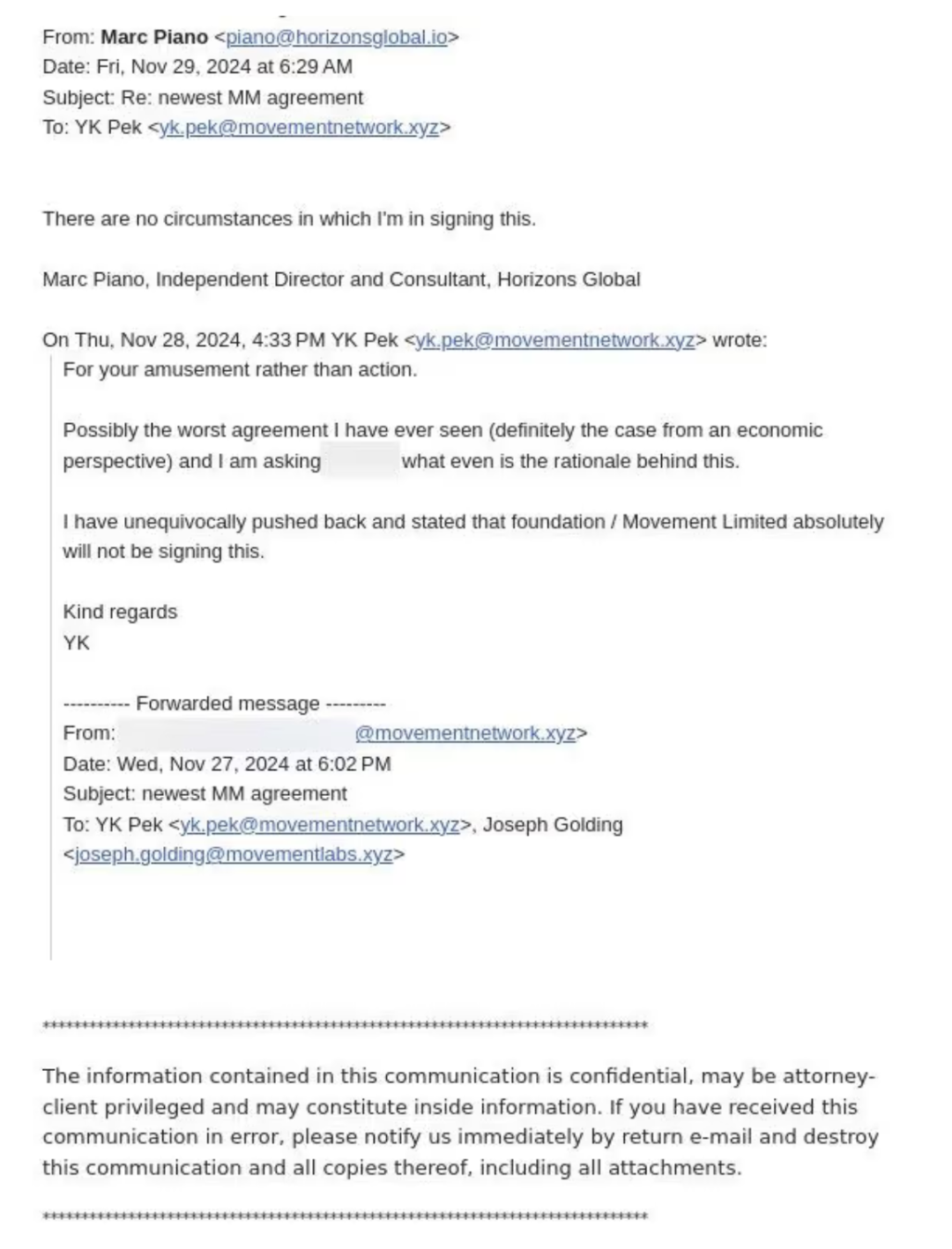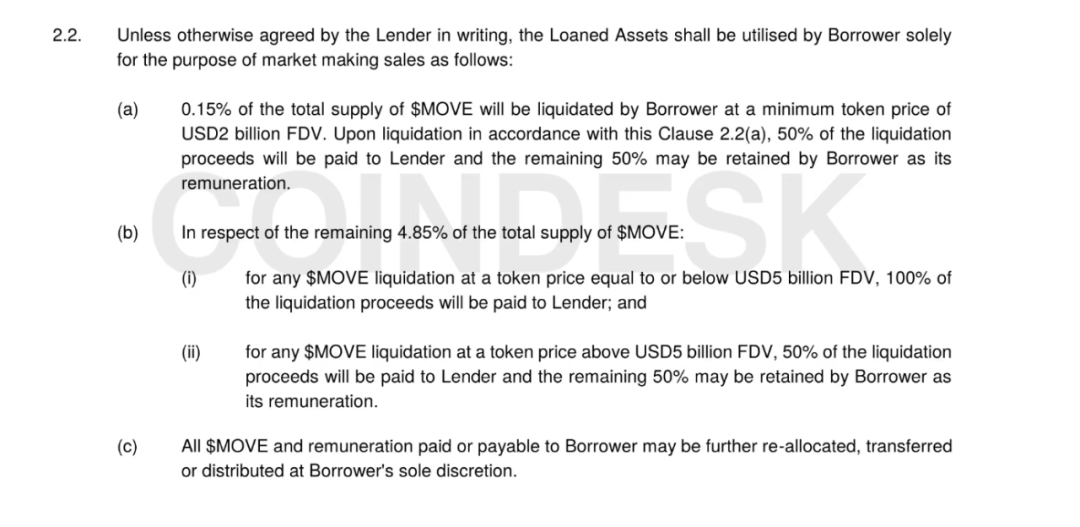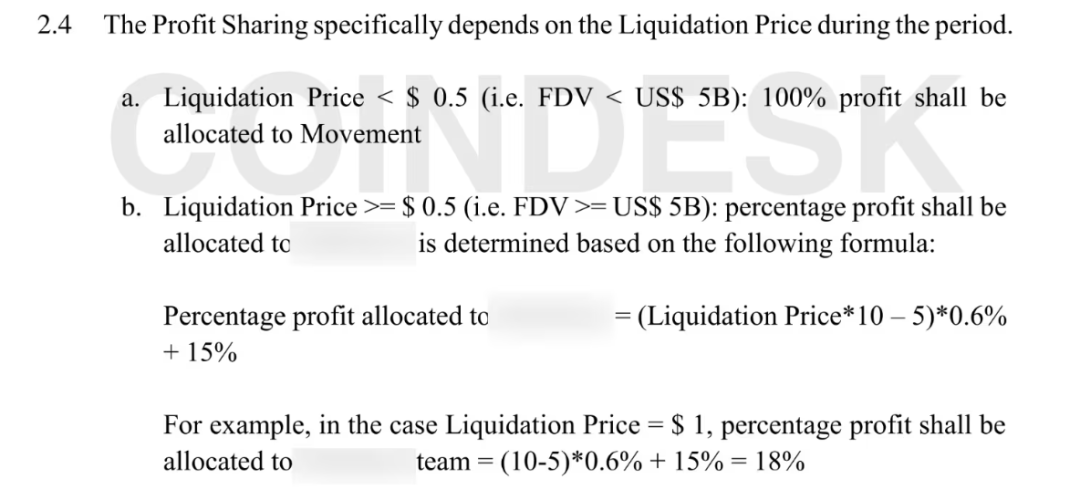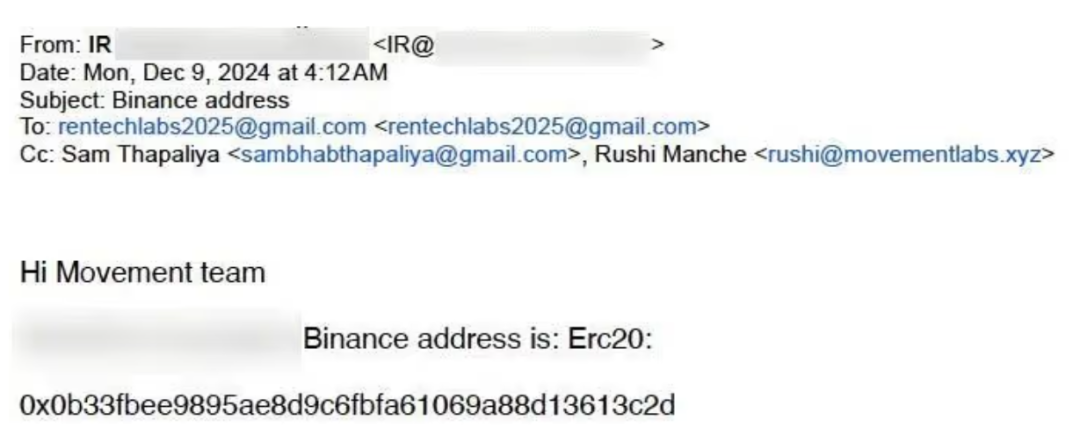CoinDesk investigation: Movement market makers sell-off scandal, secret contracts, shadow consultants and hidden middlemen

転載元: panewslab
05/01/2025·22D
Original text: Sam Kessler , CoinDesk
Compiled by: Aki Chen, Wu said blockchain
It is reported that Layer 2 blockchain project Movement Labs is investigating a suspected fraudulent market maker agreement incident. An arrangement originally designed to promote the smooth listing of MOVE crypto tokens has eventually turned into a selling scandal that shocked the market. The agreement suspected that without the project party's complete knowledge, it handed over control of 66 million MOVE tokens to a vague intermediate institution Rentech. Rentech plays the dual identities of "Web3Port subsidiary" and "foundation agent" in the agreement, and is suspected of self-transaction. The arrangement directly triggered a token selling of $38 million worth of MOVE the next day after its launch, causing a sharp drop in the currency price and causing a Binance to be banned.
Despite clear internal opposition to the agreement, senior executives have pushed for signing, raising serious concerns about governance failure, lack of due diligence and conflict of interest. At present, many senior executives and legal advisers are being reviewed, and the project governance structure and cooperation mechanism are being questioned in a comprehensive manner. The crisis revealed deep loopholes in Movement's institutional design, risk control and compliance capabilities, which may have a long-term impact on its future reputation and ecological construction.
MOVE tokens plummeted as soon as they go online, and Movement Labs is
suspected of being misled to sign a high-risk agreement
Movement Labs, the blockchain project behind MOVE crypto tokens, is launching an internal investigation into a controversial financial agreement, according to internal documents reviewed by CoinDesk. The agreement may grant the principal control of the token market to a single entity without the project party's complete knowledge, resulting in a structural imbalance.
The agreement directly led to the concentrated selling of 66 million MOVE tokens on the exchange the day after they were launched on December 9, 2025, triggering a cliff-like decline in the coin price and triggering widespread doubts in the market about "internal transactions" and interest transfer. It is worth noting that the MOVE project has received public endorsement from World Liberty Financial, a crypto venture capital fund backed by Trump, making the incident more political and industry-influential.
Cooper Scanlon, co-founder of Movement Labs, said in an internal Slack notice on April 21 that the team is investigating a key issue: how the more than 5% MOVE tokens originally reserved for market maker Web3Port were transferred to a middleman called Rentech.
Movement Foundation was allegedly told Rentech is a subsidiary of Web3Port, but the investigation revealed that this was not the case. Rentech denied any misleading behavior.

Rentech unilaterally controls nearly half of the circulation disk, and
the MOVE token circulation structure is imbalanced
According to an internal memorandum from Movement Foundation, the agreement signed between Movement and Rentech will lend approximately half of the total MOVE token supply to the single counterparty. This arrangement allowed Rentech to gain an unusual market influence in the early stages of token listing.
Many industry experts interviewed pointed out that this centralized structure seriously deviates from the decentralized distribution principle commonly pursued by crypto projects and is easily used to manipulate currency prices or achieve unilateral arbitrage.
After reviewing the contract version obtained by CoinDesk, Zaki Manian, a senior crypto industry founder, pointed out that some of the terms contained in the agreement essentially set clear incentives for "to sell off retail investors by artificially pushing up the full dilution valuation (FDV) of MOVE to more than $5 billion."
He said bluntly: "Even if such discussions appear in written documents are shocking." The comment further aggravates the outside world's doubts about the purpose and moral bottom line of the Rentech agreement.
In theory, market makers are employed by the project party and are responsible for providing liquidity services to newly launched tokens. Their responsibilities are to buy and sell funds provided by the project party within the exchange to maintain price stability and market depth. However, in practice, this role also has a risk of abuse.
Once supervision is absent or the agreement is not transparent, market makers may become tools for insiders to manipulate the market and quietly transfer large token holdings, and are not easily noticed by the outside world, thus seriously damaging the interests of ordinary investors and market fairness.
Contract exposure to encrypted gray areas: How public projects become
arbitrage tools for minority people in regulatory vacuum
A series of contract documents obtained by CoinDesk reveal a little-known gray area in the crypto industry: in the absence of effective regulatory and legal transparency, blockchain projects that were originally aimed at the public are easily used as carriers for the few people behind the scenes to make their own profits.
The content of these agreements shows that once the project party neglects the structural design and compliance control, the so-called "decentralized" project may also be completely privatized by a few traders through unequal terms, deviating from the original intention of fairness and openness.
In the crypto market, manipulation and abuse of market making mechanisms have long been common, but the specific details, contract structure and interest arrangements of related operations are rarely available to be made public. Because of this, the internal contract and agreement details disclosed by Movement Labs have become a rare window to observe the black box and market-making gray space of Web3 project operations, and have once again focused on "transparency" this most basic but most often overlooked principle.
Market maker contract reviewed by CoinDesk shows that Rentech appears in two identities in transactions with Movement Foundation: on the one hand, it acts as an agent of Movement Foundation, and on the other hand, it signs an agreement as a Web3Port subsidiary. This structure provides the possibility for Rentech to occupy "intermediary dominance" in transactions, theoretically enabling it to set transaction terms on its own and make profits from it under information asymmetry.
The market-making agreement reached by Movement and Rentech ultimately opened up a sell-off channel for a set of wallets associated with Web3Port. The Chinese financial institution claims to have served MyShell, GoPlus Security, and World Liberty Financial, a crypto fund linked to Donald Trump. The wallets quickly liquidated tokens worth about US$38 million the day after the MOVE token was first issued on the exchange, causing severe market fluctuations and also concentrating doubts about the motivation and legitimacy of the agreement arrangement itself.
Binance bans market-making accounts due to "violations", Movement
urgently initiates token repurchase
After the incident fermented, the mainstream exchange Binance has imposed a ban on the market-making accounts involved, on the grounds that "there is any misconduct." At the same time, the Movement project party urgently announced the launch of a token repurchase program in an attempt to stabilize market sentiment and restore community trust.
Similar to the option mechanism of startup employee, most crypto projects set a lock-up period when token allocation is used, aiming to restrict core teams, investors and early participants from selling large positions during the initial trading stage of the project.
This mechanism is intended to protect market stability and avoid insiders from using their information advantages to make profits in advance. However, in the Movement incident, the flow arrangement of related tokens to bypass the lock-up restrictions is the core issue that has aroused doubts from the outside world.
Binance's ban on the accounts involved quickly triggered associations in the community. Many observers believe that this may mean that the Movement project insiders and Web3Port had reached a private agreement to bypass the normal lock-up mechanism to sell tokens in advance.
Movement denied this question, insisting that it had not entered into illegal transfer arrangements with any third party. However, the information chaos and contract structure defects exposed by this incident still make it difficult to completely eliminate the impression of "inside transactions".
The Star Layer 2 project is deeply involved in controversy, and many
parties blame each other behind the Rentech agreement
Movement is an Ethereum expansion Layer 2 network built on Facebook's open source language Move. Due to technological innovation and capital support, it has quickly become one of the most discussed emerging projects in the crypto industry in recent years.
Founded by two 22-year-old co-founders Rushi Manche and Cooper Scanlon, who dropped out of Vanderbilt University, the project received $38 million in funding and was selected for the Trump-backed World Liberty Financial crypto portfolio. In January 2025, Reuters reported that Movement Labs is about to complete a new round of financing of up to $100 million, with a valuation of $3 billion.
However, there were obvious differences within the project over the controversial market-making agreement reached with Rentech. CoinDesk interviewed more than a dozen people who knew the inside story of the project (mostly requested anonymity) and they provided multiple conflicting statements.
Rentech owner Galen Law-Kun denied misleading and said the deal structure was designed in coordination with YK Pek, general counsel for the Movement Foundation. However, according to internal memos and communication records reviewed by CoinDesk, Pek initially opposed the agreement and denied participating in the establishment of Rentech.
Scanlon, co-founder of Movement Labs, said in an internal Slack message: "Movement is the victim of this incident." This statement also marks that the project's side is trying to direct responsibility to the external trader.
Movement is focusing on the role of its co-founder Rushi Manche in the Rentech agreement, according to four sources familiar with the progress of the internal investigation. It was Manchester that it was alleged that it was originally forwarded the agreement to the team and promoted the implementation of the cooperation within the organization.
Also included in the survey is Sam Thapaliya, the founder of the crypto payment agreement Zebec and a business partner of Galen Law-Kun, owner of Rentech. Although Thapaliya did not hold a formal position in Movement, she has been involved in core affairs as an "informal consultant" for a long time, and her specific influence in this incident has also become one of the focus of internal audits of the project.
Reject first and then sign, Movement bypasses the prudent mechanism to
accept high-risk agreements, and the governance structure is questioned
Despite initially rejecting a market-making agreement with Rentech, Movement eventually signed a structurally similar revised agreement, and the core dependence of the agreement is verbal assurance from an intermediate party with little public resume.
Behind this decision, the current governance structure shortcomings of the crypto industry are highlighted. According to common practice, to avoid securities regulatory risks, crypto projects usually split operations into two entities: one is responsible for token management and community resource allocation by a non-profit foundation, and the other is a for-profit development company, responsible for underlying technology development. Movement Labs is the development entity of the project, and Movement Foundation is responsible for token transactions.
But internal communication materials reviewed by CoinDesk show that the structure that should have operated independently actually fails in the Movement case. Co-founder Rushi Manche, while nominally an employee of Movement Labs, played a leading role in the key affairs of the nonprofit foundation. This overlapping function has caused the dual entity mechanism that should have prevented compliance risks to lose its due checks and balances function.

On March 28, 2025, co-founder Rushi Manche sent a draft market maker agreement to the Movement Foundation via Telegram messages and said the contract “needs to be signed as soon as possible.”
On November 27, 2025, Rentech proposed a draft market-making agreement to Movement, including lending up to 5% of the total MOVE tokens to Rentech. According to the content of the contract, Rentech is the borrower and Movement is the lender. However, the agreement was not signed in the end.
Rentech, a company with almost no public background and on-chain records, immediately aroused internal alert from the foundation. Movement Foundation legal counsel YK Pek said in an email that the document "maybe the worst agreement I've ever seen." He further pointed out in another memorandum that the implementation of the agreement is equivalent to handing over substantial control of the MOVE market to an external entity with ambiguous identity.
In addition, Marc Piano, the Foundation’s registered director of the British Virgin Islands, also refused to sign the agreement. The above objections show that Movement's internal perception of the risk of the agreement is actually very clear, but it still failed to prevent the agreement from being implemented in a variant form in the subsequent process, further exposing the problem of governance failure.

A particularly compelling clause in the contract states that once the Fully Diluted Valuation (FDV) of the MOVE token exceeds $5 billion, Rentech can begin liquidating its tokens and split it with the Movement Foundation into the resulting profit at a 50:50 ratio.
Zaki Manian, a veteran of the crypto industry, pointed out that this structure essentially creates a "distorted incentive mechanism" to encourage market makers to push up MOVE prices in order to concentrate on selling their huge holdings and embezzle profits when valuations are inflated. This design not only deviates from the original intention of market making that should serve price stability, but is also likely to directly harm the interests of retail investors.

Although Movement Foundation initially refused to sign a high-risk market-making agreement, its negotiations with Rentech were not suspended. Rentech then claimed to the foundation that it was a subsidiary of China's market maker Web3Port, and offered to offer a $60 million mortgage fund, which increased the appeal of the agreement, according to three people familiar with the matter interviewed by CoinDesk and the legal documents reviewed.
Driven by the above conditions, Movement Foundation accepted a revised agreement on December 8, 2025. This version has made changes to some key terms, removing one of the most controversial contents - if the MOVE token fails to be online on a specific exchange, Web3Port can sue the Movement Foundation for its right to compensate.
Although the agreement has been adjusted in form, this compromise decision shows that the foundation has relaxed its risk prevention stance in the face of multiple pressures and incentives, ultimately laying hidden dangers for subsequent events.

On December 8, 2025, Movement Foundation and Rentech officially signed a revised market maker agreement. Although Rentech is clearly marked as "Web3Port" in the agreement (the name has been coded in some files), its identity as the borrower has not changed, and the foundation is still the lender.
It is interesting to note that the main drafter of the agreement is YK Pek, the foundation's legal counsel who had previously clearly opposed the initial version of the agreement. Despite the revisions that have removed some of the most controversial terms, the core structure remains the same: Web3Port can still borrow 5% of the total supply of MOVE tokens and sell it in certain ways to make a profit.
Further technical information reveals the deliberate nature of the operation behind the agreement - the domain name "web3portrentech.io" registered under the mailbox of Rentech directors was completed on the day the agreement was signed.
Has the agreement been "decided first and reported later" long ago?
Web3Port and "Movement" signed a secret contract, but the foundation only learned about it later
According to three people familiar with the matter who were close to the incident, when Movement Foundation signed the formal agreement on December 8, 2025, it did not realize that Web3Port had signed a similar cooperation agreement with the nominal "Movement".
This "pre-employment agreement" not only did not go through the formal process of the foundation, but also bypassed the due compliance review and governance mechanism.
According to a contract obtained by CoinDesk dated November 25, 2025, Web3Port signed a highly similar market maker agreement with Rentech long before the Movement Foundation was officially signed. In this agreement, Rentech is marked as the lender, Web3Port is the borrower, and Rentech is directly called the representative of "Movement" in the document.
This "shadow agreement" almost replicates the original proposal content that the foundation subsequently rejected, indicating that some key arrangements have long been implemented in informal channels and have not been approved by the foundation. The discovery confirms that there are multiple "power channels" within the project.

The early agreement signed on November 25 is highly structurally consistent with the contract rejected on November 27, and the core clauses still clearly allow market makers to clear when the price of MOVE tokens reaches a specific threshold.
This setting is regarded by industry insiders such as Zaki Manian as a core mechanism of "extremely manipulating risks" - that is, by artificially promoting the centralized selling of prices after meeting standards, extracting profits from it. This shows that even in subsequent versions after superficial modifications, some key stakeholders behind the project have always promoted a set of operational paths with built-in arbitrage incentives, and have not substantially eliminated the fundamental risks.
"Shadow Co-founder"? The behind-the-scenes pusher surfaced, and the
founder of Zebec was accused of deeply participating in the design of the protocol structure
Several sources close to the Movement project revealed to CoinDesk that there are still many speculations surrounding the real planners of the Rentech agreement. The initial version of this agreement, which is believed to directly lead to the massive sell-off of MOVE tokens in December and a public opinion storm, was circulated internally by co-founder Rushi Manche, and he promoted the inclusion in the decision-making process.
According to Blockworks, Manchester was briefly suspended last week due to the agreement involved. Manche himself responded that in the process of choosing a market maker, MVMT Labs has always relied on the foundation team and multiple consultants to provide advice and assistance, "but it seems that at least one foundation member represents the interests of both parties to the agreement, which has become the focus of our current investigation."
Meanwhile, another key figure, Sam Thapaliya, has also attracted great attention. Thapaliya is the founder of the crypto payment protocol Zebec and a long-time consultant to Manchester and co-founder Scanlon. He was cc in many emails he communicated between Web3Port and Movement, and appeared in important communications with Rentech and Manchester.
This clue reinforces the outside world's doubts that Thapaliya may play the role of "behind the scenes" in Rentech's structural design - he may not be a pure consultant, but a "shadow co-founder" who dominates the protocol structure and deeply interferes in decision-making.

According to several Movement employees, Zebec founder Sam Thapaliya may play a practical role within the project that is far beyond his consultant status. Some people call him “the close advisor to Rushi (Manche), the third co-founder of Shadow in a sense” and noted: “Rushi has always been secretive about this relationship, and we usually only hear his name occasionally.”
Another employee said: “A lot of times we have agreed on a certain matter, but there will always be changes at the end of the day, and we usually know that it may be Sam’s opinion.”
According to three witnesses, Thapaliya appeared at the office site of Movement in San Francisco on the day the MOVE token was launched to the public. CoinDesk also reviewed several Telegram screenshots, showing that co-founder Scanlon had commissioned Thapaliya to assist in screening the MOVE airdrop list - a highly sensitive part of the project's community token distribution mechanism.
Such arrangements further deepened the impression of some team members: Thapaliya's actual influence in the project is far deeper and more concealed than the public identity shows. In response to CoinDesk, Thapaliya said that he met Manchester and Scanlon in college in his early years and has been involved in the project as an external consultant, but he "has no shares in Movement Labs, has not obtained tokens from Movement Foundation, and has no decision-making power."
Who is Rentech? The mysterious middle-level organization has many
entanglements, and the founder and the project legal counsel blame each other
Rentech, which is at the heart of this MOVE token dispute, was founded by Galen Law-Kun - a business partner of Zebec founder Sam Thapaliya. Law-Kun told CoinDesk that Rentech is a subsidiary of Autonomy, a Singapore-registered financial services company, aiming to bridge financing for crypto projects and Asian family offices.
Law-Kun claims that YK Pek, general counsel for Movement Foundation, has not only assisted in the establishment of Autonomy SG, but also general counsel for Rentech, the company (or its affiliate). He also said that although Pek strongly opposed the Rentech agreement internally, he actually helped design the Rentech structure and participated in the drafting of the initial version of the market-making agreement, "its content is almost consistent with the contract version he later formally drafted for the foundation."
However, CoinDesk's investigation did not find direct evidence that Pek served in Autonomy or drafted any Rentech-related contracts in that capacity.
In response, Pek responded: "I have never, nor have I been the general counsel of Galen or any of its entities." He explained that a corporate secretarial service company he co-founded did provide secretarial services to two companies under Galen, but these two companies are not Rentech, and they both declared "assetless" in their 2025 annual review.
Pek further stated that he had taken two hours to review Galen’s consultant agreement with a project in 2024, and had only given free advice on the FTX case deadline and NDA instruments. “I totally don’t understand why Galen claims I’m his general counsel, which makes me confused and upset.”
Pek also pointed out that the legal teams of Movement Foundation and Movement Labs were introduced by co-founder Rushi Manche to learn about GS Legal, the lawyer hired by Rentech.
In Galen's statement, Pek was introduced to 10 different projects as "Autonomy Legal Counsel", and never denied this title; as for GS Legal's intervention, "it was just a formal process completed in accordance with the requirements of Movement."
After the incident broke out, Cooper Scanlon, co-founder of Movement Labs, emphasized in an internal Slack notice that the company has hired an external audit agency Groom Lake to conduct a third-party independent investigation into the abnormal situation in recent market making arrangements. He stressed again: “Movement is the victim in this incident.”
This series of mutual denials and accusations exposed the complex interpersonal and legal relationships behind Rentech, and further pushed the MOVE storm from market events to the core vortex of trust crisis and governance faults.



 chaincatcher
chaincatcher
